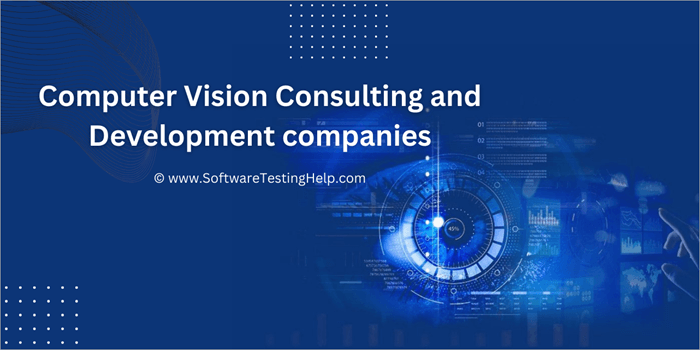The field of computer vision is rapidly evolving, transforming industries and offering innovative solutions across various sectors. Computer vision software development services leverage the power of artificial intelligence (AI) and machine learning (ML) to enable computers to “see” and interpret images and videos, much like humans do. This comprehensive guide delves into the intricacies of these services, exploring their applications, development processes, and the key considerations for businesses seeking to integrate this transformative technology.

Understanding Computer Vision Software Development
Computer vision software development involves creating algorithms and systems that allow computers to extract meaningful information from visual data. This involves several key stages, from data acquisition and preprocessing to model training, validation, and deployment. The ultimate goal is to build applications that can accurately identify objects, track movement, recognize patterns, and make decisions based on visual input. This requires a deep understanding of image processing techniques, machine learning models, and software engineering principles.
Core Components of Computer Vision Systems
- Image Acquisition: This involves capturing images or videos using various devices like cameras, drones, or satellites. The quality of the acquired data significantly impacts the performance of the computer vision system.
- Preprocessing: Raw images often require preprocessing to enhance their quality and reduce noise. This may include techniques like image filtering, resizing, and normalization.
- Feature Extraction: This stage involves identifying and extracting relevant features from the images, such as edges, corners, textures, and colors. These features are then used to train machine learning models.
- Model Training: Machine learning algorithms, such as convolutional neural networks (CNNs), are trained on large datasets of labeled images to learn patterns and relationships between features and objects. This is a crucial step that determines the accuracy and performance of the system.
- Model Validation and Testing: The trained model is rigorously tested on unseen data to evaluate its performance and identify potential biases or inaccuracies. Metrics like precision, recall, and F1-score are commonly used to assess model performance.
- Deployment and Integration: Once the model is validated, it’s deployed into a real-world application, which might involve integrating it with existing systems or creating a new application altogether.
Applications of Computer Vision Software Development Services
The applications of computer vision are vast and continue to expand. Here are some key areas where these services are making a significant impact:
1. Healthcare:
- Medical Image Analysis: Detecting diseases like cancer from X-rays, MRIs, and CT scans.
- Robotic Surgery: Guiding surgical instruments with precision and accuracy.
- Patient Monitoring: Analyzing patient vital signs and behavior using video cameras.
2. Automotive:
- Autonomous Vehicles: Enabling self-driving cars to perceive their surroundings and navigate safely.
- Advanced Driver-Assistance Systems (ADAS): Providing features like lane departure warning, adaptive cruise control, and automatic emergency braking.
- Parking Assistance: Helping drivers find and park their vehicles easily.
3. Retail:
- Customer Behavior Analysis: Understanding customer preferences and shopping patterns through video analytics.
- Inventory Management: Automatically tracking stock levels and identifying missing items.
- Self-Checkout Systems: Enabling customers to scan and pay for their purchases without assistance.
4. Security and Surveillance:
- Facial Recognition: Identifying individuals for security purposes.
- Object Detection: Detecting suspicious activities or objects in real-time.
- License Plate Recognition: Identifying vehicles and their drivers for law enforcement.
5. Manufacturing:
- Quality Control: Inspecting products for defects and ensuring quality standards.
- Predictive Maintenance: Identifying potential equipment failures before they occur.
- Robotics: Guiding robots in assembly lines and other manufacturing processes.
Choosing the Right Computer Vision Software Development Partner
Selecting a reliable partner for your computer vision software development project is crucial. Consider the following factors:
- Experience and Expertise: Look for a partner with a proven track record in developing successful computer vision applications. Assess their experience in your specific industry and application area.
- Technical Capabilities: Evaluate their expertise in relevant technologies, including deep learning frameworks (TensorFlow, PyTorch), cloud platforms (AWS, Azure, GCP), and relevant programming languages (Python, C++).
- Data Handling and Security: Ensure they have robust processes for handling sensitive data and comply with relevant data privacy regulations.
- Communication and Collaboration: Effective communication is essential for a successful project. Choose a partner that is responsive, transparent, and collaborative.
- Project Management Capabilities: A strong project management approach ensures the project is delivered on time and within budget.
Frequently Asked Questions (FAQ)
- Q: What is the cost of developing a computer vision application? A: The cost varies significantly depending on the complexity of the application, the size of the dataset, and the required features. It’s best to get a customized quote from a software development company.
- Q: How long does it take to develop a computer vision application? A: The development time depends on the project’s scope and complexity. Simple applications might take a few months, while more complex ones could take years.
- Q: What type of data is needed for training a computer vision model? A: You need a large, high-quality dataset of labeled images or videos relevant to your application. The more data you have, the better the model’s performance.
- Q: What are the ethical considerations of using computer vision? A: Ethical concerns include bias in algorithms, privacy violations, and potential misuse of the technology. It’s crucial to address these issues during the development and deployment phases.
- Q: What are the future trends in computer vision? A: Future trends include advancements in deep learning, the use of edge computing, and the development of more robust and explainable AI systems.
References
Call to Action
Ready to leverage the power of computer vision for your business? Contact us today to discuss your project requirements and explore how our expert team can help you build innovative and effective computer vision solutions.

